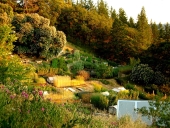





Travis Schulert wrote:
They CAN be separated as long as the person doing it understands what they are doing and not just skipping steps and cutting corners. There is no discovery in this world without experimentation.
I myself do not like following someones system to a T. Because what works for them on their land and in their trials is not always whats going to work for everyone else. You can also measure the organic matter in your soil through a lab and know for sure if you are depleting it or not. With only adding a half inch of compost on each bed my first year with Bio-Intensive, I gained almost 2% organic matter. That was due largely in part to the amount of composting roots in the soil.
I preach to everyone to experiment wherever they can, and learn what works best for them.
I no longer make big compost piles on a weekly basis, or turn on a regular basis as bio-intensive would have you do. I instead compost most material in place on the bed as a sheet mulch. I also source as much compost material as I can from other parts of the farm. I do make compost piles but thats mostly for the chickens and for my compost tea.
Fermented plant extracts are something Bio-Intensive does not touch on, but using those methods with nettle, mullien, horsetail, etc etc you can add mass amounts of nutrients to your soil and plants by utilizing the growing tips of local weeds growing in the margins of roads and around the farm.
Fermented plant extracts make the plants bigger, that means more roots and material to compost without having added compost to make them bigger in the first place. Now thats my kind of nutrient cycling lol
Glad you are having good success with Bio-Intensive. I have noticed huge improvements in my soil with these methods, and also the methods of many other natural farming systems, not just bio-intensive. I use a lot of straight bio-dynamic methods that John does not include in his book also.
 In addition, I get more quantitatively out of my piles if I do not turn. I keep good records on my piles, so this I am confident of. Also, the type of materials you include in the pile, namely more structural lignins and such will also go a long way to increase longer term soil organic matter...food for thought!
In addition, I get more quantitatively out of my piles if I do not turn. I keep good records on my piles, so this I am confident of. Also, the type of materials you include in the pile, namely more structural lignins and such will also go a long way to increase longer term soil organic matter...food for thought!

Tyler Ludens wrote:
Matthew Drewno wrote:Unfortunately I live in a location where composting my own humanure is not an option
I'm wondering about that. Do you actually have "poop police" who make sure you aren't composting human poop? It might be impossible to get a permit for a composting toilet, but it's difficult for me to imagine living in a place where people are so intrusive they look at your compost heaps to make sure there's no human poop in there. We have a composting toilet outhouse on our place, but one can only get a permit for septic systems, as far as I know. My big personal rule of behavior is "Don't flounce." So far I've never been prevented from doing something because someone wouldn't give me permission to do it. Just sayin'
